Timeline of Human Prehistory: Research Paper Sample on the Paleolithic Age
- Type of Paper: Essay
- Topic: People, Human, Humans, Spread, Species, Middle East, Population, Coast
- Pages: 21
- Words: 5775
- Published: 2018/10/12
The research sample paper below is a great pillar for those students who specialize in human prehistory and the first civilizations. It starts from describing the general state of affairs in the infancy of mankind by answering questions like "When did the Paleolithic era begin?", "What hominid species existed at that time?", "What was the climate and how did it affect the migration process of the first people?" Thanks to reading this paper, you have a chance to see with your very eyes how much effort it takes to craft a worthy research paper. Yeah, and mind that on this page, you'll see JUST ONE part of the entire work (there are THREE MORE PARTS). If the perspective of birth pangs of such a mammoth piece still leaves you undaunted – all sails to the wind and full ahead! Alternatively, you can turn to the external help of professional history essay writer who will protect you from stress, save your time, and deliver a high-quality paper right when you need it.
Human Prehistory
This article is divided into the following parts:
- Part I: General context of human life in the Paleolithic (this page)
- Part II: The Lower Paleolithic
- Part III: The Middle Paleolithic
- Part IV: The Upper Paleolithic
The Paleolithic
The Paleolithic is divided into 3 periods: the lower, middle, and upper (stratigraphy-type division, with the lower being oldest). Each is marked by different cultures, which are differentiated by characteristic technologies.
|
Divisions of the Old Stone Age
|
|||
| Lower Paleolithic | Oldowan | 2.6 - 0.5 million years ago | Earliest known stone tool industry |
| Acheulian | 1.65m - 100k years ago | Earliest use of fire, about 1.5 m. y. a. (controversial) | |
| Clactonian | 400k - 200k years ago | Oldest "home" construction, Terra Amata | |
| Middle Paleolithic | Mousterian | 300k - 30,000 years ago | Age of the Neanderthals |
| Aterian | 100k - 30,000 years ago | Bead jewelry, 80,000 years old from Morocco | |
| Upper Paleolithic | Chatelperronian | 35,000 - 29,000 years ago | Cave art at Chauvet |
| Aurignacian | 42,000 - 26,000 years ago | Earliest carving of human: Venus of Hohle Fels | |
| Gravettian | 28,000 - 22,000 years ago | Venus of Willendorf | |
| Solutrean | 19,000 - 15,000 years ago | Altamira cave paintings | |
| Magdalenian | 18,000 - 10,000 years ago | Earliest permanent settlements in Nile Valley | |
As we can see from the table above, the Paleolithic covers a fair amount of time, about 2.6 million years. This is a very heterogeneous period, and should not be treated as one entity. Besides the 2.6 million-years span, it covers several species of hominids, the evolution of modern man, a wide range of climate changes as ice ages came and went, and the dispersal of various hominid species across the globe.
For these reasons, let’s go over some background before getting into the details of the various stone industries that give these periods their names.
Hominid Species
Several species of hominids existed during the Paleolithic. The beginning of the Paleolithic is marked by the appearance of Homo habilis, around 2.6 million years ago in South and East Africa, and persisted until about 1.4 million years ago. The chart on the right shows the dates and geographical distribution of different hominid species. Note that this is an area of active research and not all anthropologists agree on any particular hominid evolutionary tree.
There have been long periods when several hominid species co-existed; therefore, there is a good deal of overlap between them. Also, the classification is by no means final. Some anthropologists believe that Homo habilis is better included with the Australopithecines. Others defend its position on the hominid branch because Homo habilis had slightly larger brains and smaller molars than the Australopithecines.
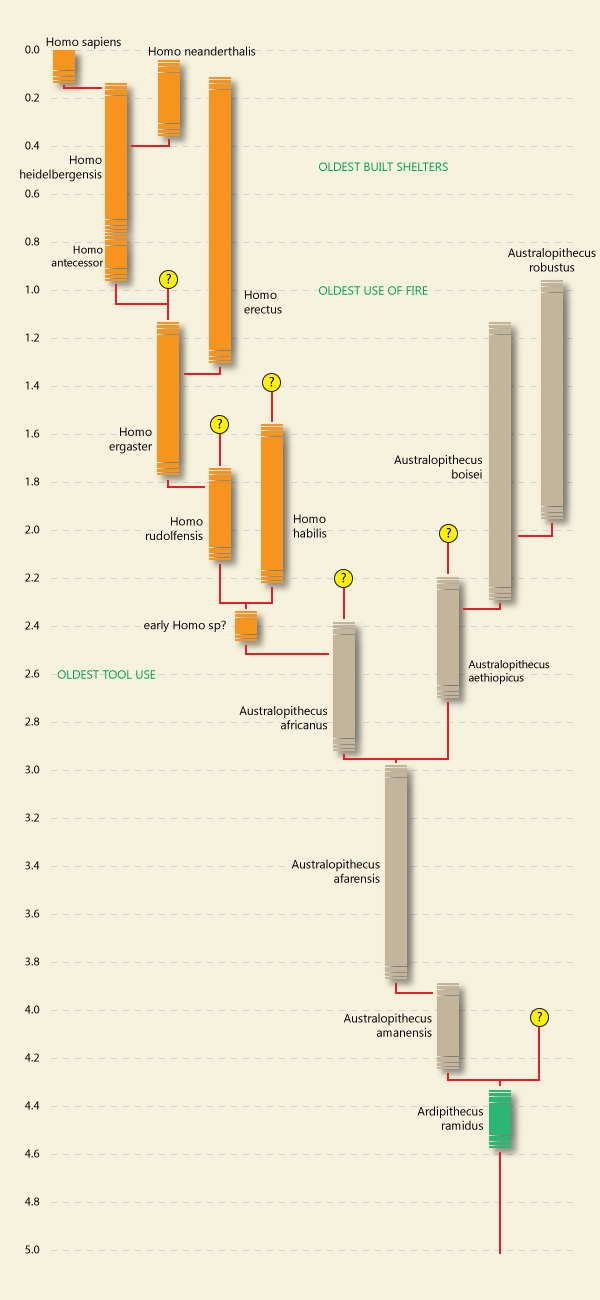
Homo erectus appeared around 1.8m years ago and survived as late as 50,000 years ago. Some anthropologists consider early Homo erectus (1.8m to 1.25m years ago) to be a separate species, named Homo ergaster. They prefer to reserve the name Homo erectus only for the Asiatic branch of Homo ergaster. When considered this way, Homo ergaster is the direct descendant of Homo habilis, while Homo erectus appeared around 1.5m – 1.0m years ago, primarily in Asia. Homo erectus was the first hominid to walk completely upright (locking knees). There is no clear consensus regarding when Homo erectus went extinct. There is a lot of variation in the dates offered. H. erectus went extinct in Africa as early as 1 million years ago, and the most recent dates in Asia until recently were 300,000 years ago in China. However, some H. erectus finds at the Solo River Terrace site in Java, Indonesia, have been dated to a much younger age, recent as 35 – 50,000 years old. This would mean that H. erectus co-existed with modern H. sapiens, who arrived in Indonesia more than 50,000 years ago. However, a recent study casts doubt on the recent dates from Indonesia and suggests that they are probably no more recent than 150,000 years old. This would still be the most recent evidence of the survival of H. erectus, but it rules out any co-existence with H. sapiens in that part of the world. Although (very!) controversial, it is possible that H. erectus may have survived until as recently as 12,000 years ago in the form of Homo floresiensis.
Homo antecessor and Homo mauritanicus are the European and African versions of Homo erectus, which existed roughly from 1.2m to 800,000 years ago. They are more modern versions of Homo ergaster, intermediate between ergaster and rhodesiensis/heidelbergensis.
Homo heidelbergensis inhabited Europe between 600,000 and 250,000 years ago and is possibly the last common ancestor of modern humans and Neanderthals. Homo rhodesiensis is the contemporary African version. Many anthropologists believe that Homo rhodesiensis and Homo heidelbergensis were the same species. In Africa, there is a distinct difference between the Acheulian tools made before and after 600,000 BP. Stone tools suddenly improved around this time (became thinner and more extensively trimmed). Anthropologists believe this may be due to the emergence of Homo rhodesiensis.
Homo neanderthalis appeared in Europe around 250,000 years ago. There is ongoing debate whether this is a separate species or just a geographically specialized form of Homo sapiens. The consensus seems to be that it is indeed a separate species. There is also controversy whether there was any gene mixing between Homo neanderthalis and Homo sapiens.
Homo sapiens idaltu is known from a few skulls found in the Herto region of Ethiopia. These skulls are about 160,000 years old. Some anthropologists believe that this is the most archaic form of Homo sapiens yet discovered and that he evolved directly from Homo rhodesiensis. If so, Homo sapiens arose in Africa around 160,000 years ago and then spread to the rest of the world. However, more recent reports suggest that Homo sapiens may be older – possibly up to 200,000 years old. Skulls found in Ethiopia in 1967 (the Omo I and Omo II skulls), were previously dated to about 130,000 years old, making the Herto skulls the oldest modern human remains. However, the Omo I and Omo II skulls were recently redated to 195,000 years old, which makes them the oldest. Omo II is more primitive in appearance than Omo I, and yet they are roughly from the same period. This possibly indicates a period of transition, when humans with significantly different characterstics coexisted. The mitochondrial divergence of Homo sapiens is dated to around 110,000 years ago at the latest, in Eastern Africa.
Climate
The Paleolithic covers three epochs: the Pliocene, Pleistocene and the Holocene. [Note: This may be revised soon. The Pliocene is currently said to span the period from 5.33-1.8 million years ago. However, new recommendations from the International Union for Quaternary Research suggest moving the last stage of the Pliocene - the Gelasian - from the Pliocene to the Pleistocene, to be more consistent with changes in the Earth's climate and biota. This change would mean that the Pliocene would only cover the period from 5.33-2.59 million years ago, and the Pleistocene would be expanded to include the Gelasian, making it the period from 2.59 million years ago up to about 11,000 years ago, which is considered the start of the Holocene. Since the genus Homo has existed for about 2.6 million years, this would put the Paleolithic and the existence of Homo entirely within the Pleistocene and Holocene.]
| Epoch | Age | Million years ago |
| Holocene | 0.0117 | |
| Pleistocene | Upper | 0.126 - 0.0117 |
| Ionian | 0.781 - 0.126 | |
| Calabrian | 1.806 - 0.781 | |
| Gelasian | 2.588 - 1.806 | |
| Pliocene | Piacenzian | 3.6 - 2.588 |
| Zanclean | 5.332 - 3.6 |
The Earth’s climate had been in a slow cooling trend for at least 13 million years, but the start of the Quaternary period and the dawn of man sharpened the cooling trend and began a cycle of glaciations that continues to this day. These cycles include cool periods called glacials when the region of Earth under year-round snow cover advances southwards from the north pole (and vice versa in the southern hemisphere). At their peak, as much as 30% of the land area may be covered by glaciers. In between the glacials, there are warmer periods called interglacials, when the ice retreats. This current cycle of glacials and interglacials began about 2.5 million years ago, with a frequency of about one cycle every 41,000 years. Since the last million years or so, the cycles have slowed down, and occur at a rate of once every 100,000 years. The Earth is currently in the middle of an interglacial, or warm period in this long glaciation event that has lasted for 2.5 million years.

Within the larger context of glacials and interglacials, there is a finer grained variation of climate. There are brief periods during a interglacials (warm periods) when the climate gets slightly colder - these periods are called stadials. Similarly, there are brief periods during glacials when the climate gets slightly warmer, called interstadials. For example, the Little Ice Age in Europe may have been a stadial, a brief colder period during the current interglacial.
Earth's past climate can be estimated based on various measurements on ice cores drilled from places which have been under constant glaciation for millions of years. Some well known ice cores include the Vostok core from Vostok station in the Antarctica, and the EPICA/Dome C Core, also from the Antarctica. The chart on the left shows a record of the past 5.5 million years of Earth's climate. The past half million years show three major glaciations: the Mindel, Riss and Würm glacials. The Würm glacial was the most recent, which peaked around 18,000 years ago. We are currently in the interglacial following that.
It's interesting to speculate on the role of these sharp climate changes in the evolution of species in the genus Homo, and more generally, over the past 5 million years of anthropoid evolution that leads to man. The continents have not changed much in the 2.5 million years since Homo has been around. Estimates of continental drift indicate that the continents have been pretty much where they are now, or not more than 100 km of drift in this time. However, glaciations lock up an enormous amount of water into ice on land, which lowers sea levels significantly, up to 100 meters or more. This can open up land bridges to connect islands or continents which are not accessible to migrating humans or animals in warmer times. This has certainly played a role in the spread of mankind. Climate changes also force migrations when an unfavorable climate makes the land less productive, and unable to support the population living there. People living in a resource scarce or otherwise hostile environment also may develop technologies and behaviors to help them cope with it. Finally, climate influences natural selection, favoring genetic traits that confer a survival advantage in that climate. Skin color, body shape, etc. may be such adaptations.
As can be seen in the figure above (under the section "Hominid Species"), Homo ergaster was the first hominid to migrate out from Africa, reaching the Middle East, Asia and Europe around 1.8 million years ago. For much of the paleolithic, various branches of hominids, mostly derived from Homo erectus, have populated Africa, Asia, and Europe. The science of human species is still in flux, and because of the very small number of fossils discovered so far, it is often not possible to establish the species concept clearly. With a larger range of specimens, one can have some idea of the amount and type of variation that exists within a species. Lacking this information, a new set of bones that looks somewhat different can easily be classified as a "new" species, since no one really knows if it's sufficiently different from other existing species which existed at that time to not fall within the limits of their variability. So we can expect that as our knowledge grows, the number of species will both grow (with new discoveries) and shrink (as people realize that specimens used to define new species weren't so different after all).
The maps below show the migration of modern humans from their origins in Africa to the rest of the world. Please note that the maps are approximate, and new discoveries may modify the timeline.
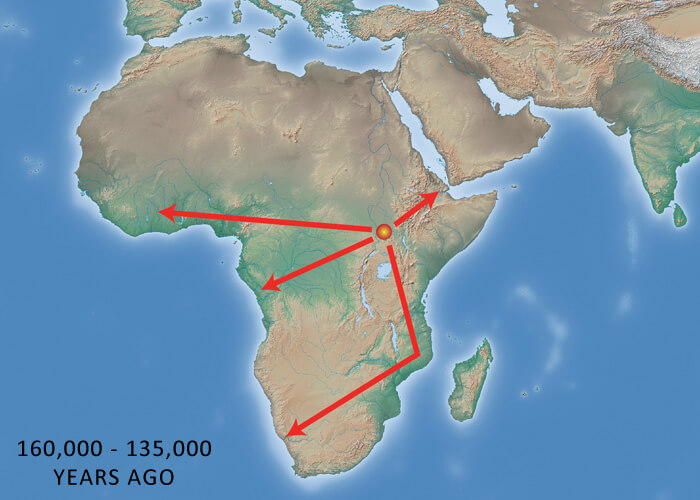
Modern humans originated in East Africa about 200,000 to 160,000 years ago. Over the next 50,000 years, they spread to south Africa and the west coast, as well as towards Ethiopia.

A group of humans moved north along the Nile, and crossed the Sinai to settle in the Levant, about 115,000 years ago.
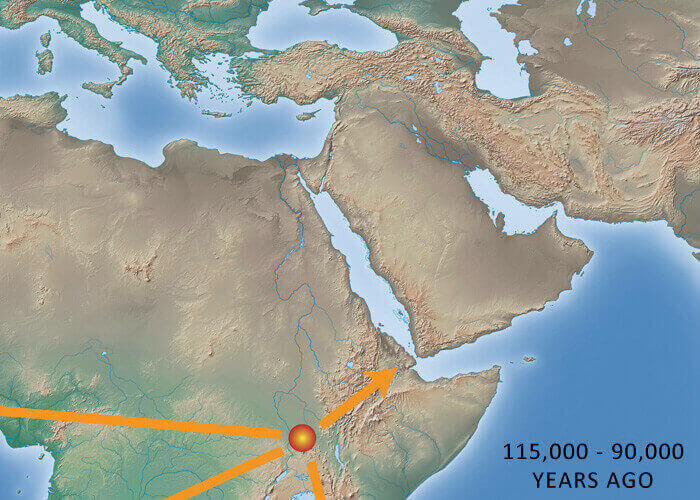
Changing climate ended the early colonization of the Levant, and the Levant and Egypt became uninhabitable.
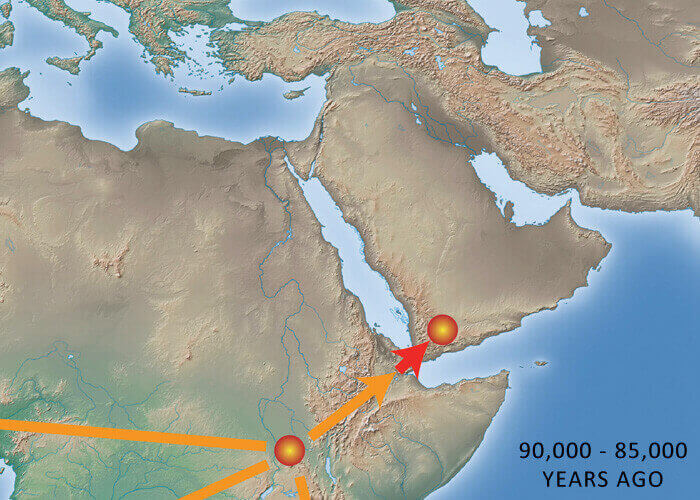
A group of humans crossed the Red Sea into Arabia. All non-African humans today are the descendents of these people.
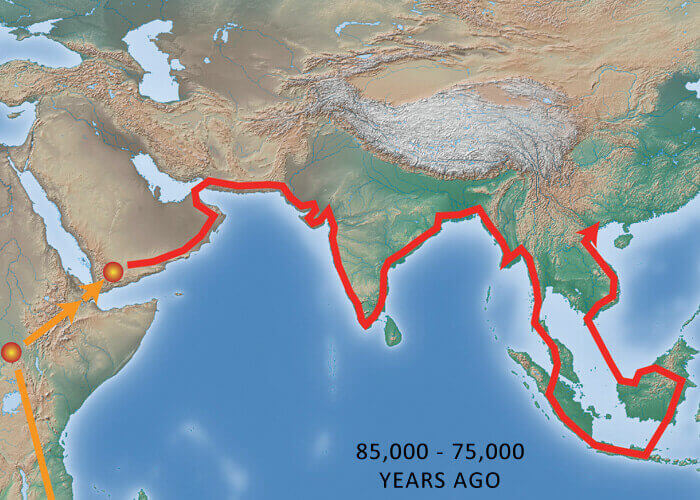
Humans rapidly spread along the coast of southern and southeast Asia all the way to China.
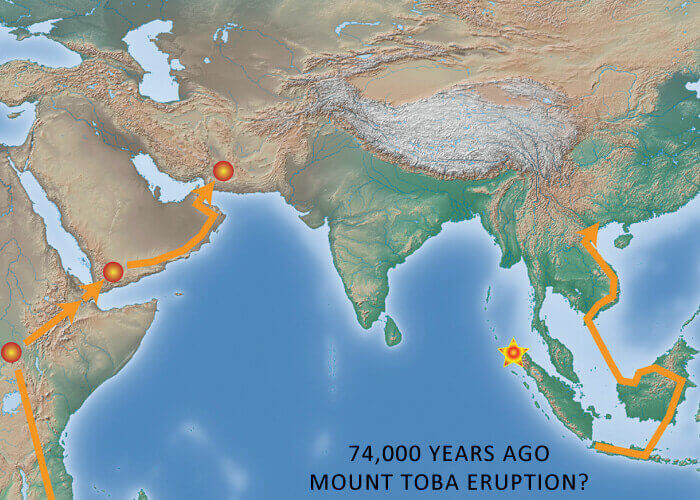
Some natural catastrophe (perhaps the Mount Toba eruption) wiped out the population in many areas and brought humanity perilously close to extinction.

After the eruption, humans again began colonizing south east Asia. Extensive glaciation lowered sea levels to create a land bridge to Australia.
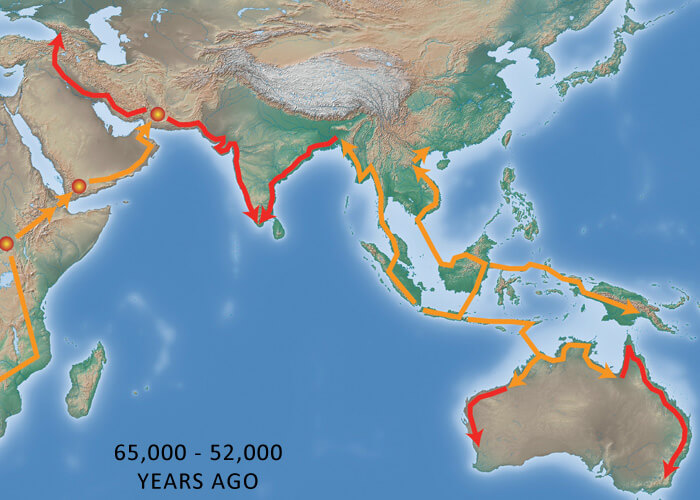
India was repopulated through an eastern and a western branch. From Iran, people moved to populate the fertile crescent (modern Iraq and Syria).
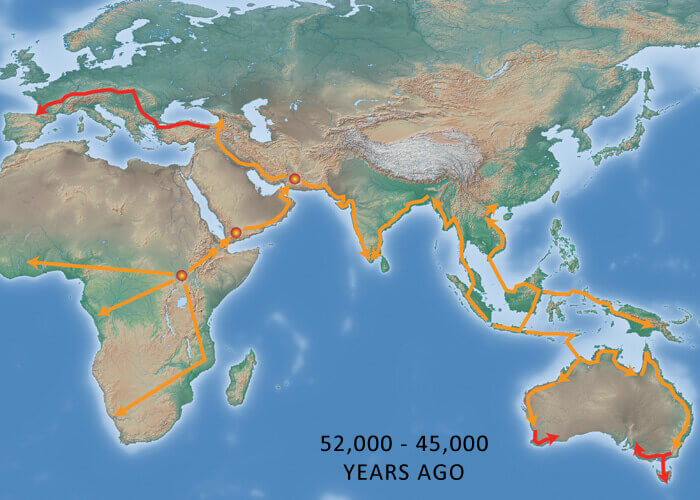
From Turkey, humans crossed the Bosphorus to populate Europe, through Bulgaria, along the Danube to Hungary, Austria, and eventually, France.
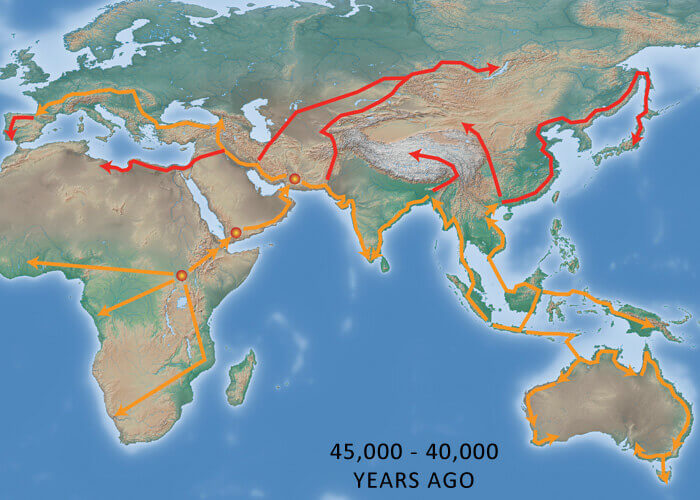
Japan was populated from China. Tibet was populated from east India. Also from India and Iran people spread to central Asia. Spain and Portugal were populated from France.
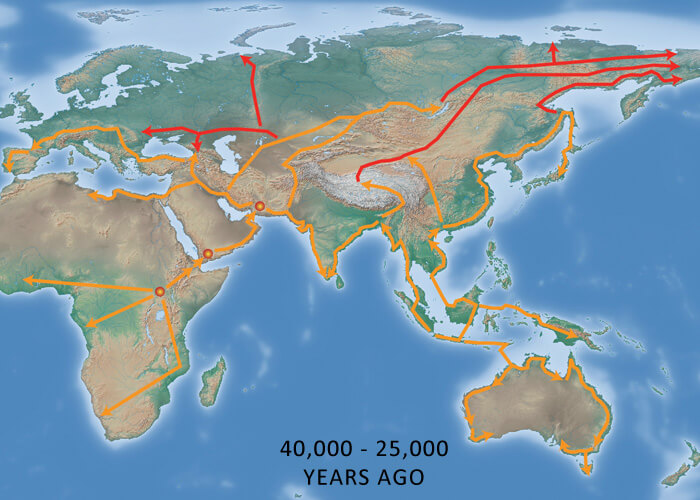
People moved to Berengia (eastern Siberia) from China and central Asia. Populations near the Caspian and Aral seas moved to eastern Europe.
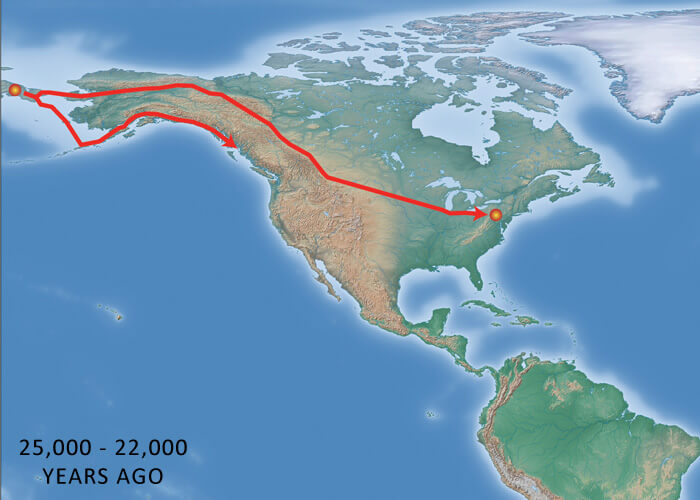
During a brief break in the glaciation, people from Berengia moved to North America. They followed a coastal route as well as an inland route in an ice-free corridor to the northeast US.
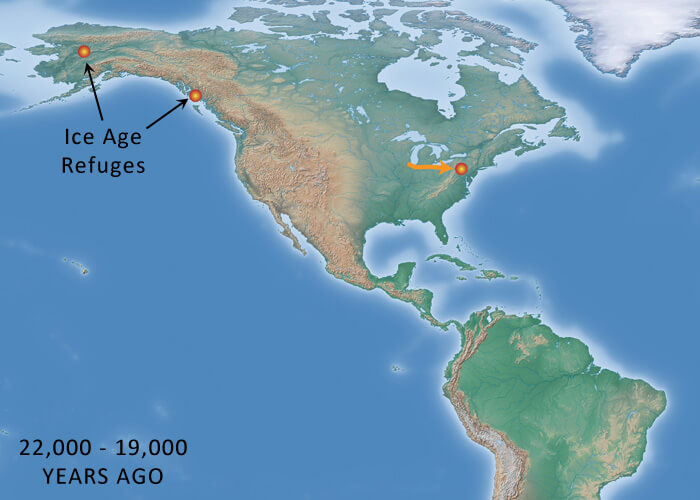
Returning glaciers cut off further ingress into the Americas for a while. The early immigrants sustained themselves in a few isolated refuges in Alaska and the northeast US.

The beginning of the end of the ice age marked migrations from the northeast US southwards along the east coast. Humans entered South America for the first time.
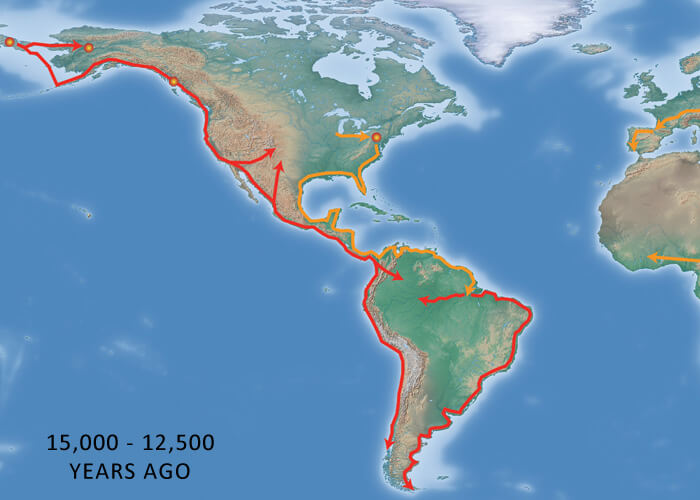
As the glaciers retreated, the passage across the Bering Strait reopened, leading to more waves of people. These were possibly Clovis people, who spread along the west coast to South America.
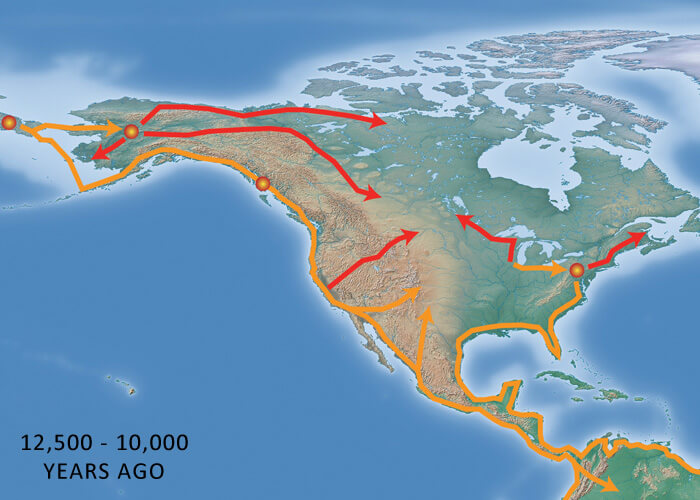
From northern sites in Alaska, the frozen north was populated with the ancestors of Aleuts, Eskimos, Na-Dene people. Central Canada was populated from both the east and west coasts.
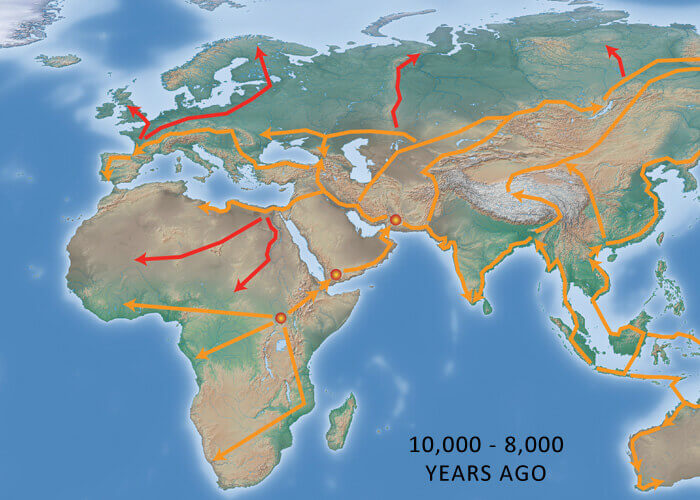
People from France crossed the English Channel to populate the British Isles. People from northern France and Germany also moved north to populate Scandinavia. Populations from north of the Caspian Sea moved north to populate the European part of Russia. In Africa, people from Egypt moved southwest, across the Sahara (which was grassland at the time), to populate regions south of the Sahara.
A Few More Details about the Migrations
The following is a more detailed description of the migrations. Remember, these descriptions refer only to the migration of our own species, Homo sapiens, from Africa to the rest of the world. Other hominids migrated out of Africa long before these migrations, and already covered much of the world at the time our species began radiating from Africa.
Our own species, Homo sapiens, originated in East Africa around 200,000 years ago. This is supported by both archeological and genetic studies. Over the next 50,000 - 75,000 years, they spread across the southern and western parts of Africa. Some time around 125,000 years ago, a group of early humans traveled up the Nile and the Sahara desert (which wasn't a desert at all at the time), across the Sinai, and into the levant. This was the first migration of modern humans out of Africa.
This was a bad time for humans to leave Africa. The period from about 115,000 to 90,000 years ago coincided with the onset of the Würm glaciation. The advancing glaciers across northern Europe turned north Africa and the levant into a dry desert, and this early branch of humanity to leave Africa perished. This is typical of the history of human migrations throughout the stone age. Waves of migrations occur periodically. Some end in disaster, only to be replaced by fresh migrations later.
The next attempt to leave Africa happened about 85,000 years ago. A group of humans living in the region that is now Ethiopia / Eritrea / Djibouti, crossed the Red Sea to the Arabian Peninsula, into the south-western tip of what is now Yemen. All non-African humans alive today have descended from this group of people. Over the next 10,000 years (from 85,000 to 75,000 years ago), this group rapidly spread across along a coastal path - across the southern edge of Arabia, through Yemen, Oman, crossing the Persian Gulf into Iran. Following the coastline, they continued southwards through Iran, Pakistan, all the way around the coastline of India, into southeast Asia. They spread across the islands of Indonesia, and a wave then turned north, to colonize the southern coast of China. Thus in a short period of 10,000 years, humanity had spread from Africa to cover almost the entire southern coast of Asia. Since this was during a glacial, the sea level was much lower, and there may have been land bridges to allow access to the islands of Indonesia.
About 74,000 years ago, another disaster struck humanity. This was the eruption of the volcano Mount Toba, on the island of Sumatra, in Indonesia. This massive eruption produced a winter that may have lasted for 6 years, and pretty much wiped out humanity. Genetic studies show that the human population went through a bottleneck, in which it may have fallen to as low as a population of 10,000 adult human beings in the whole world. This genetic bottleneck happened 75 - 70,000 years ago, which coincides with the eruption of Mount Toba. While the effects of the "volcanic winter" were worldwide, they were devastating to the people west of the eruption (due to prevailing trade winds, which blow east to west across southern Asia). It's estimated that India and Pakistan were covered 5 meters deep in ash from the eruption. The eruption completely wiped out the population west of Toba - through Cambodia, Thailand, Burma, all of India and Pakistan, up to southern Iran. Outside Africa, only a thin band of humans remained, across southern Arabia, and those who had already moved east of Toba, including the eastern Indonesian islands, and the southern coast of China.
Over the next 10,000 years, from about 73,000 to 65,000 years ago, the human population re-established itself, and started radiating again, primarily from its center in east Asia. This was one of the colder parts of the Würm glacial, so sea levels were unusually low. This enabled humans to reach Australia and New Guinea for the first time, probably through a land bridge. Humans also spread northwards, populating the coast of China almost to the Yellow Sea, and also started to spread back westwards towards India. By about 65,000 years ago, humans had re-occupied much of southeast Asia, up to Thailand, Burma and the eastern part of India.
Over the next 13,000 years, from 65,000 to 52,000 years ago, humans repopulated India. This happened from two directions: populations in Burma and Bangladesh populating India from the east, and populations in Iran populating India from the west. Populations from Iran also moved westwards, across Iraq and the fertile crescent, reaching Turkey and the gates of Europe for the first time. Early populations which had migrated to Australia continued to move southwards, along the east and west Australian coasts.
Between 52,000 and 45,000 years ago, humans cross the Bosphorus and passed from Turkey into Europe. They moved across Bulgaria, along the Danube into Hungary and then Austria and southern France. Over the next 5,000 years (from 45,000 - 40,000 years ago) there were several waves of migrations. Going from east to west:
- People from coastal China moved northwards along the coast, eventually finding their way into Japan along the coastal route from southern Russia and Sakhalin island. They also spread inland into China, populating the eastern half of China.
- From Indo-China, mostly from eastern India and Burma, people moved northwards across the eastern edge of the Himalayas, into the Tibetan plateau.
- From western India, Pakistan and Iran, people moved north-eastwards, populating Afghanistan, former Soviet republics such as Turkmenistan, Uzbekistan, Kazakhstan, and the steppes of central Asia.
- Also from the fertile crescent, people moved westwards across northern Arabia, the levant and Sinai, back into Africa, where the populated the northern or Mediterranean coastline of Africa.
- From France and Austria, people moved south-west into Spain and Portugal, reaching the Atlantic coast.
Over the next 15,000 years (from about 40,000 to 25,000 years ago), populations from central Asia spread westwards in three directions: westwards into eastern Europe, north towards the Arctic Circle (ancestors of the people who inhabit the Siberian tundra today), and east towards eastern Siberia and Berengia. In this last, they were joined by populations from central China and the south-eastern coast of Russia (near Japan), who also migrated north-east to Berengia. This was a period of great artistic developments for humans. Cave paintings from Chauvet, the earliest Venus figurines, etc. are all from this time.
Between 25,000 and 22,000 years ago began the first wave of settlement of north America. This was the first time that hominids of any sort had ever reached the Americas. Populations from Berengia crossed the land bridge between Berengia and Alaska - the Bering Land Bridge - into north America. Some of them undoubtedly took the coastal route southwards, across the western coast of Alaska and Canada. There is some evidence that another group cut across an inland ice-free corridor across Canada, ending up in the north eastern United States (see the Meadowcraft site). If they did this, it must have been before the last glacial maximum started, around 22,000 years ago.
The period between 22,000 and 19,000 years ago was the last glacial maximum, the last "ice age". During this period, many northern areas became depopulated. Most of northern Europe, Asia and America was abandoned by humans, except for little pockets of people that stayed to survive the harsh conditions. Both the land bridge and the coastal route across the Bering Strait became ice-locked and impassable. However, people who had already established themselves far enough to the south, mostly in the eastern part of the United States, managed to survive. This is probably responsible for the "anomalous" spread of population in the Americas, which seems to originate from and eastern source rather than from the west, closer to the Bering Strait.
Between 19,000 and 15,000 years ago, humans spread from centers in the northeast US southwards, along the east coast of the US into Mexico, Central America, and into the South American continent, reaching coastal areas in the northern part of Brazil. Over the next 2.500 years (from 15,000 to 12,500 years ago), these people continued to spread along the eastern coast of South America, reaching the very southern tip of South America. However, during this period, the ice age started to decline, and the land bridge across the Bering Strait was open once again. This lead to another wave of people from Berengia moving into Alaska. These people followed the western coastal route, across Canada, the US, Central America, and South America. They populated the western coast so quickly, that in 2,500 years, they had spread all the way across the western coast of the Americas, from Alaska to Monte Verde in Chile. It's possible that these people were the "Clovis" people. Both eastern and western coastal people in South America spread inland in the north during this period - the eastern group along the Amazon into Amazonia, the western group into Colombia and the Andes.
Between 12,500 and 10,000 years ago, people spread out from Berengia into much of Northern Canada, becoming the ancestors of the Aleuts, Eskimos and Na-Dene speakers. From centers of population in the northeast and northwestern US, people spread out to south central Canada, including the region of the Great Lakes.
About 10,000 years ago, the ice age finally ended. Between 10,000 and 8,000 years ago, people finally spread to northern Europe, which had been covered with ice sheets. People from France spread northwards into Scandinavia, and also crossed the channel to populate the British isles. People from the areas north of the Caspian and Aral seas moved further north, to populate northern European Russia. Finally, people from Egypt, and the levant spread across the Sahara (which was grassland at the time), to populate areas in the southern Sahara.
Having covered some of the context for human life in the paleolithic, let's move on to specific stages of the paleolithic. Read on about lower paleolithic.
If you don't have time to delve into details of when was the Paleolithic age or how the hominid species were doing during that period, then opt to assignment writing help to get the job done in a proper and timely manner.
Cite the page
- APA
- MLA
- Harvard
- Vancouver
- Chicago
- ASA
- IEEE
- AMA
If you want a unique paper, you can have one of our writers create it for you
Ours Services
Related Essays
Academic Essays Database Has All You Need to Succeed
- Essay
- Research Paper
- Case Study
- Report
- Critical Thinking
- Article Review
- Argumentative Essay
- Term Paper
- Literature Review
- Business Plan
- Research Proposal
- Creative Writing
- Cover Letter
- Dissertation Conclusion
- Dissertation Methodology
- Dissertation Proposal
- Dissertation Abstract
- Dissertation Hypothesis
- Dissertation Chapter
- Dissertation Results
- Dissertation Introduction
- Thesis
- Thesis Statement
- Business Proposal
- Biography
- Annotated Bibliography
- Admission Essay
- Movie Review
- Thesis Proposal
- Personal Statement
- Coursework
- Book Review



